As most of you know, I wrote the Riyria Revelations — all six books — before the first was published. As a result, for the last three years I have done nothing but edit. The editing is almost done, and as the end of the series approaches, I have begun thinking about my next novel, even written a couple of chapters.
I had forgotten what a rush it can be to create something out of nothing. In some ways it is almost like that movie The Neverending Story where the world is just a black Nothing. I stare at the keyboard, the cursor blinking at me, a singular line pulsating like a silent heartbeat. I think. I imagine. And a light appears in the Nothing. I can see it, this new world taking shape and my fingers begin moving. Building, growing, feeding off itself; scenes, faces, voices, I get lost in it. When I come out, I scroll back and look at the pages. Nothing was there before, now people exist.
There is a sense of pride and satisfaction in the act of creation that I had forgotten. The initial rush that has nothing to do with anyone else. This is the kind of feeling that makes you stand up and move, to do a fist pump and grin in the mirror.
Writing again, starting a project from scratch, has made me consider the process. Traditionally I do everything the hard way, and it recently occurred to me that there might be new technology that could help. I wrote my first few books on a manual typewriter. A word processor was quite the improvement and as it has been a while, I thought I would do some investigating to what else might be available.
I write on a PC. Always have, (at least since the Computer Age,) and since the early nineties I’ve used Microsoft Word. Word is not exactly designed for the needs of a novelist, but rather for business in general and has everything possible stuffed into it and little in the way of customization allowed. So I was looking forward to finding a tool that was designed with me, and my profession, in mind.
Doing a search on writing software results in a number of highly structured programs designed to help those who know nothing about how to craft a story or create a manuscript. These aren’t tools for serious writers. They are the literary equivalent of what a paint-by-numbers kit would be to a serious artist. That’s not to say that there aren’t any genuine tools.
While I hadn’t heard of any PC programs of note, on the Mac side of the world, I had heard about a program called Scrivener. There might be others, but this is the one that writers with Mac Books raved about.
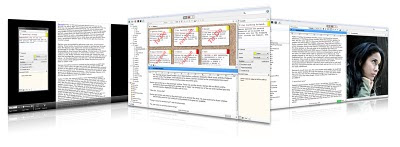
It looks marvelous and recently I discovered there is going to be a Scrivener for Windows. They are in the open beta phase now and “It will be officially released in early 2011.” I downloaded the beta and played with the program. I must admit it is very nice, although it suffers from its infancy.
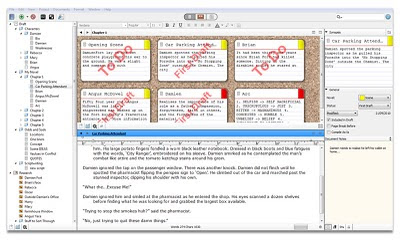
Most writing programs have at their core a word processor and few can hope to beat the gorilla of MS Word for quality and depth. Word has been around since 1983 when free demonstration copies of the application were bundled with the November 1983 issue of PC World, making it the first program to be distributed on-disk with a magazine. A program that has been around for almost three decades, is going to have an edge when it comes to wealth of features and the time to tweak them. As a result, any would-be PC replacement needed to be fantastic just to match up. Sadly, when it comes to the word processor portion of the program, Scrivener doesn’t. That is not unexpected. Scrivener hasn’t had time to even add all the features of the Mac version, so I try not to hold that against it. The rest of the program is wonderful as it introduced me to the concept of having an in-program file system.
Along the left side of the main Scrivener window is a Windows Explorer type of file and folder tree that allows the user to click on, and instantly jump, to another file. This means that you can organize (by drag-and-drop) and instantly open notes, images, or look at an outline, without leaving the word processor. This is convenient and saves the effort of opening windows, finding the files, opening them, adjusting the placement of the windows, etc. It also supports images. I liked this feature quite a bit. I also thought the corkboard where you had a virtual place to layout index cards with notes on them, was fun.
After a greater search for other PC programs I found one called Liquid Story Binder. This one looks native to the PC and has had a lot more time to develop. As a result, it has a ton of features. Initially I found LSBX a bit complicated due to the intent by the designers to create a tool that allowed the writer the flexibility to use their tool anyway they wanted. Luckily there are a number of good YouTube tutorials.
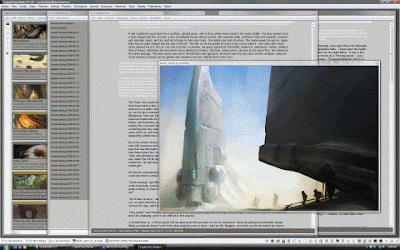
Once more, in addition to the word processor, LSBX allows for jumping around to different files inside the program, but in addition also has nifty things like a Timeline, Character Dossiers, and Mindmaps. There are also word usage programs that help show when you reuse a word too often, and a bunch of other statistics that might be interesting to an author (or more importantly an editor.) It has storyboarding, image galleries, even a music player to be used for audio inspiration.

LSBX looks great too, like a computer game or an art program. Just flipping through the program’s website is impressive. The program doesn’t come that way. All those beautiful images are things that you, as the writer, are expected to add for research or inspiration.
While both of these products were fun to play with, I had to ask myself, would they really help the writing process? Setting up the programs, filling in all the various files, fields, maintaining the character sheets, and outlines is a lot of work and quite time consuming. In many ways it reminded me of the computer game City of Heroes where the character creation process (being very well conceived) was often more fun than playing the game itself. In order to make LSBX look and work like it was designed to, would take several hours, days or weeks (depending on how elaborate you want to be.) The thought of having to set all this up for each new project seemed a bit daunting, and unnecessary. I’ve written nineteen novels and never needed to do any of this before.
Novel writing doesn’t require much. A pen and paper will do. A word processor and a notebook is better – good even. All the rest of this I determined was just another distraction, another way to avoid the actual writing. The prerequisite for working goes from the hours put into organizing a real world writing space, to the added task of organizing a virtual writing space.
There were two aspects to these programs that I did find beneficial: the ability to access my notes without having to open a new file, and the Timeline feature. The question is: Was this worth the added effort of using either of these programs?
I strongly considered it, being that I like playing with new things, but the killer was the word processor. Neither has Word. As I tested these other programs I continuously encountered situations where I could not do something I used to, or not as easily. This was the deal-breaker. The added features are nice, but I must have a word processor that does what I need it to.
This got me thinking. Was it possible to add these features to Word? Word has add-ons. Perhaps some enterprising programmer made plug-ins for writers. After several hours of searching I did find Writing Outliner, a Word Add-on that installed a Scrivener style file tree in Word, but after using the demo for this, I was not impressed and found it more of an annoyance.
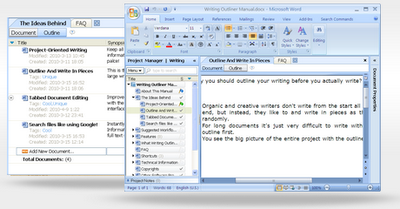
I was irritated that Word had so many capabilities but could not be customized to suit novel writing. All I really wanted was the file access and a timeliner, and maybe the ability to make the giant ribbon disappear to give me more room and clear the clutter. Then it occurred to me that I never even tried. I touched on the idea that a timeline was nothing more than a spreadsheet, and MS Office comes with Excel.

I gave it a try and in a few minutes was able to create a timeline for my new story that was more suited to my needs than the ones in the other programs. This only left a means of accessing notes within Word. Then it hit me — the Document Map.
Turning on the Document Map creates a side window in Word similar the one in Scrivener. The problem is that clicking on the contents only takes you to various headers in the open file and not to new files. The question that I hit on was, “Why do the notes have to be in separate files?”
One of the many praised aspects of Scrivener is its ability to let you work in separate files and then auto-combine, or compile them into a single manuscript file. I never saw the benefit of this as I write in linear fashion, so my manuscripts are always in a single file. For me, having multiple files only adds to the confusion. In addition to keeping track of my story, I also have to keep track of where all these separate files are. Did I file that scene under this character, that one, or setting? Can I delete that file now that I placed it in a chapter? I tend to keep things, so soon the files would be cluttered with redundancies and old info. Even when I just used Word, I still have a few note files running around that I lose track of.
The idea of keeping everything in a single mapped file was intriguing. The sheer simplicity was beautiful, at least as an idea. I needed to test out the theory.
For years I have used the Doc Map to jump from chapter to chapter, and scene to scene within the chapters, but now as I planned to take it to new lengths I put more thought into the whole thing. I created new headers and styles to suit my needs and then began dumping all my notes at the start of my manuscript file. Once there, I divided them into sections: Outline, Characters, Setting, and Notes. Each of these had subheads. I offset the text with color and font to separate it from my actual writing to avoid confusion and reduce the length by putting the notes in a smaller font.
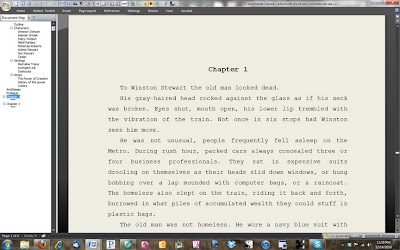
I even pulled some of the images I had created while using the other programs and placed them in the appropriate sections. Now with a simple click I could instantly jump to read any note, reference, or view any aspect of my outline using the collapsible-tree Doc Map. And another click would send me back to work. And rather than use a compile tool to generate a finished manuscript file, I just highlight and delete the note portion off the top. Simple.
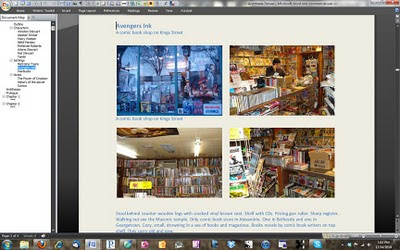
I also discovered that the ribbon bar can be minimized into near non-existence, and there is a full-screen mode that leaves only the text and the Doc Map visible. Add to this the discovery that you can alter the color of the page and Word has been transformed into a very neat, efficient, and similar facsimile to the other writer programs. This one however, uses my familiar Word as the processor.
While this solution still lacks some of the more sophisticated and fun toys, they are merely toys and as such would serve more to distract than help the writing process.
Honestly, I don’t know why Microsoft doesn’t release multiple flavors of their flagship processor. With just a few tweaks to the existing program they could offer Word for Novelists, Word for Managers, Word for Journalists, Word for Screen Writers, Word for Salesmen, Word for Executives, Word for Editors, Word for Teachers. The list could be endless, and so could the revenue.
So if you are in the market for a Scrivener-like program for Windows, you’re in luck, Scrivener itself will be available real soon. And if you want to play with a highly customizable writing program, you can try LSBX. But if you already have Word and would just like to make the writing process a tad more efficient, you might try customizing it using the Doc Map and the custom menu bar as I have. It isn’t as pretty, but it works.




















